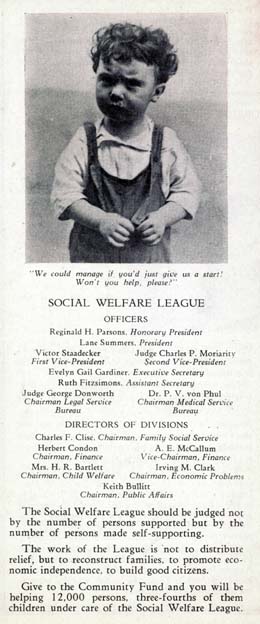This People's History is based on the early records of Wellspring Family Services, a private, non-profit organization helping families and children in Seattle and King County overcome life’s challenges. Founded in 1892 as the Bureau of Associated Charities, Wellspring Family Services has operated under a succession of names. At the time of the events described in this essay, it was called the Seattle Social Welfare League. This essay discusses a 1926 fundraising brochure, comparing it with modern (2010) fundraising materials. The organization's services have changed over the years, but have always centered on a commitment to a stronger, healthier community. Wellspring’s archives illuminate the development of social work as a profession, the growth of the non-profit sector, and the relationship between private non-profits and governmental agencies. This is one of a series entitled "Out of the Archives," and appeared in November 2011 in Wellspring's monthly internal newsletter, The Fiddlehead. It was written by Wellspring Family Services executive assistant Deborah Townsend.
Not Alms, But A Friend
Here’s a general agency brochure from 1926. It’s an 8x18 inch sheet, double-folded to 4x9, inches that describes the Seattle Social Welfare League, as we were then called. "Not alms but a Friend," the cover declares. "Charity alone creates Paupers. Social Service Plus Friendship creates Good Citizens."
As our agency materials still do today, this brochure features client stories and photos to touch the reader’s heart. Open the sheet all the way up and there are three client stories answering the headline question "What is Social Service?" One story describes an unhappy couple struggling with debt and the wife’s mental health issues (described here as "nerves" and "hysteria"). Another story describes a woman abandoned by her husband, living in a single dark damp basement room with four children. The third describes an Italian mother of five, recently widowed and "bewildered by life in an American city." The Social Welfare League helped these families with debt counseling and budget training, medical and legal assistance, job placement, and improved housing. Each happy ending gives credit to the supportive relationship with the social worker. We would use different words today, but in each case we can recognize the multiple barriers and the long-term, coordinated-services these families needed.
The other pages of the brochure hint at something else going on in our agency. Social work was a very new profession, and the Social Welfare League was apparently a local leader in applying its principles. In 1921, five years before this piece came out, our agency had helped create the Community Fund, later renamed United Way, and had begun to move away from giving emergency relief -- typically cash assistance, food, clothing, and fuel -- toward what we might call holistic or wrap-around service to families. Obviously the League had heard questions about costs and the number of clients served, because the brochure frequently repeats a message about the essential differences between social service and emergency relief. For example:
- "Social service should cost more than food or fuel, just as the doctor costs more than the drugs."
- "Service or relief -- which should cost more? If you want to help people IN their poverty, invest in relief. If you want to help people OUT OF poverty, invest in service."
- "It costs less in the long run to reconstruct people with skillful service than to maintain them on the ragged edge of poverty."
- "The Social Welfare League should be judged not by the number of persons supported but by the number of persons made self-supporting."
Again, we would use different words today -- and we might not be quite so heavy-handed in an informational brochure -- but we certainly know about having to explain what it is we do, particularly around helping families out of homelessness into stability, and why it takes so long and (apparently) costs so much.

